22-Day S. America, Antarctica & Solar Eclipse
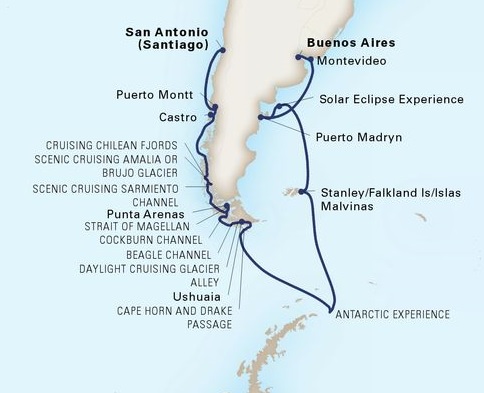
Starting from
$4,349*
San Antonio (Santiago), Chile to Buenos Aires, Argentina
Ship: ms Westerdam
Departure Date :
Optional tours are available from most ports for an additional charge.
Itinerary
Day San Antonio (Santiago), ChileDeparts 05:00 PM
"A day or two of sightseeing is all it takes for visitors to ValparaÃso and Santiago to fall in love. They'll find great places to eat, stunning architecture, fascinating museums to visit and myriad things to do in these diverse and extraordinary cities. Color dominates the seaport city of ValparaÃso: Brightly painted houses cling intrepidly to steep hillsides along labyrinthine streets that rise from the blue Pacific. The harbor is busy with fishing boats, cargo ships, and naval vessels. Rich in naval and commercial history, ValparaÃso suffered from the opening of the Panama Canal, and this decline is still apparent in the ramshackle charm of many structures. Nevertheless, ValparaÃso is having a renaissance on all fronts, and its bohemian culture and emphasis on the arts are felt and seen everywhere. For a visitor, the city itself is the main attraction, and a walking tour amply repays the effort: Street art abounds along the route to Pablo Neruda's house, La Sebastiana; the Iglesia de la Matriz; the Naval Museum; and even the funiculars that carry you up the steep hills. In 2003, validating the enduring pride of porteños, as the locals are called, UNESCO designated one-fourth of ValparaÃso a World Heritage Site. Stately and monumental Santiago, 120 kilometers (75 miles) inland, is encircled by the Andes. Santiago offers the visitor such important museums and public buildings as the Museo Precolombino and Palacio and Centro Cultural de La Moneda. A walk along Paseo Ahumada to the Plaza de Armas and thence to the old Mercado Central gives a taste of many different facets of the city. "
"A day or two of sightseeing is all it takes for visitors to ValparaÃso and Santiago to fall in love. They'll find great places to eat, stunning architecture, fascinating museums to visit and myriad things to do in these diverse and extraordinary cities. Color dominates the seaport city of ValparaÃso: Brightly painted houses cling intrepidly to steep hillsides along labyrinthine streets that rise from the blue Pacific. The harbor is busy with fishing boats, cargo ships, and naval vessels. Rich in naval and commercial history, ValparaÃso suffered from the opening of the Panama Canal, and this decline is still apparent in the ramshackle charm of many structures. Nevertheless, ValparaÃso is having a renaissance on all fronts, and its bohemian culture and emphasis on the arts are felt and seen everywhere. For a visitor, the city itself is the main attraction, and a walking tour amply repays the effort: Street art abounds along the route to Pablo Neruda's house, La Sebastiana; the Iglesia de la Matriz; the Naval Museum; and even the funiculars that carry you up the steep hills. In 2003, validating the enduring pride of porteños, as the locals are called, UNESCO designated one-fourth of ValparaÃso a World Heritage Site. Stately and monumental Santiago, 120 kilometers (75 miles) inland, is encircled by the Andes. Santiago offers the visitor such important museums and public buildings as the Museo Precolombino and Palacio and Centro Cultural de La Moneda. A walk along Paseo Ahumada to the Plaza de Armas and thence to the old Mercado Central gives a taste of many different facets of the city. "
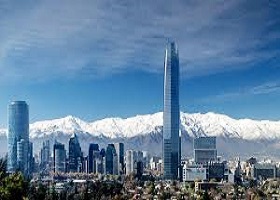
Day At Sea
Day Puerto Montt, ChileArrives 08:00 AM Departs 05:00 PM
"Puerto Montt, the capital of the Los Lagos region of Chile, is often called the gateway to the country's glacial lakes, volcanic landscapes and surrounding national parks. The port is also home to an over-100-year-old German settlement as well as to indigenous communities of Mapuche people. Adventure travelers often base themselves here and in Puerto Varas when planning treks to Chiloé and Patagonia. Even a short visit, however, provides a fascinating look into Chile's diverse cultures and offers a taste of the country's stunning scenery. From a stroll around Puerto Varas overlooking Lake Llanquihue, one of Chile's largest lakes, to a meal in the fishing village of Angelmó of the practically still-snapping catch of the day, washed down with a traditional German-style white wine, Puerto Montt is a fascinating introduction to southern Chile and the people who make their home in one of the world's most photogenic landscapes. "
"Puerto Montt, the capital of the Los Lagos region of Chile, is often called the gateway to the country's glacial lakes, volcanic landscapes and surrounding national parks. The port is also home to an over-100-year-old German settlement as well as to indigenous communities of Mapuche people. Adventure travelers often base themselves here and in Puerto Varas when planning treks to Chiloé and Patagonia. Even a short visit, however, provides a fascinating look into Chile's diverse cultures and offers a taste of the country's stunning scenery. From a stroll around Puerto Varas overlooking Lake Llanquihue, one of Chile's largest lakes, to a meal in the fishing village of Angelmó of the practically still-snapping catch of the day, washed down with a traditional German-style white wine, Puerto Montt is a fascinating introduction to southern Chile and the people who make their home in one of the world's most photogenic landscapes. "
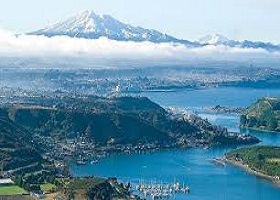
Day Castro, Isla Chiloe, ChileArrives 08:00 AM Departs 05:00 PM
"Founded in 1567 by the Spanish, Castro is Chile's third-oldest city and home to roughly 29,000 people. It is the transportation hub and tourism center of Chiloéâa 41-island archipelago which includes Isla Grande de Chiloé, the continent's fifth-largest island and where Castro is found. Traces of the area's past can be found in the historic churchesâ16 of which are UNESCO World Heritage Sitesâthat dot the isle. Another form of arresting architecture exists in the palafitos, the region's unique waterfront wooden homes that sit atop stilts. The city of Castro itself is a walker's paradise. A stroll south from the main square (the Plaza de Armas, where the Iglesia de San Francisco is located) to the Museo Regional and on to the Mercado Artesanal de Castro along the coast provides a delightful itinerary. Just outside the town center is the Museo de Arte Moderno on a hilltop in a municipal park, where there are lovely views of the city and the bay. Each February, the Festival Costumbrista of Chilote food, crafts, music and dance takes over the area and is equally popular with locals and visitors to Castro. "
"Founded in 1567 by the Spanish, Castro is Chile's third-oldest city and home to roughly 29,000 people. It is the transportation hub and tourism center of Chiloéâa 41-island archipelago which includes Isla Grande de Chiloé, the continent's fifth-largest island and where Castro is found. Traces of the area's past can be found in the historic churchesâ16 of which are UNESCO World Heritage Sitesâthat dot the isle. Another form of arresting architecture exists in the palafitos, the region's unique waterfront wooden homes that sit atop stilts. The city of Castro itself is a walker's paradise. A stroll south from the main square (the Plaza de Armas, where the Iglesia de San Francisco is located) to the Museo Regional and on to the Mercado Artesanal de Castro along the coast provides a delightful itinerary. Just outside the town center is the Museo de Arte Moderno on a hilltop in a municipal park, where there are lovely views of the city and the bay. Each February, the Festival Costumbrista of Chilote food, crafts, music and dance takes over the area and is equally popular with locals and visitors to Castro. "
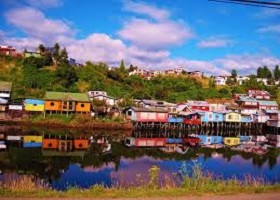
Day Chilean FjordsCruising Only
"Much like the Norwegian coastline, the west coast of Chile is sliced by dramatic inlets, or fjords, lined with rugged mountains and glacier-covered valleys. This spectacular stretch of coastline starts near the Reloncavà Estuary (roughly halfway down the long spine of Chile) and extends south to the very end of the continent, at Tierra del Fuego. It's a distance of some 1,500 kilometers (930 miles), as the crow flies. Travel here, however, is never in a straight lineâinstead ships follow meandering paths along the many fjords and channels. The area is known for its desolate beauty and not surprisingly it's home to many of Chile's national parks, including Alerce Andino, Hornopirén and Vicente Pérez Rosales, as well as the Llanquihue National Reserve and the Cochamó Valley. Early Spanish explorers came here in search of the mythical City of the Caesars, whose people were believed to be rich in gold and diamonds. Though the city was never found, the explorers added much to the world's navigational knowledge and at the same time established shipping routes that have been used ever since. Similarly, the riches that travelers to the region today discover are measured not in ounces or carats but in gasps of wonder at the stunning scenery of this windswept, dramatic land and its unusual animal residents. "
"Much like the Norwegian coastline, the west coast of Chile is sliced by dramatic inlets, or fjords, lined with rugged mountains and glacier-covered valleys. This spectacular stretch of coastline starts near the Reloncavà Estuary (roughly halfway down the long spine of Chile) and extends south to the very end of the continent, at Tierra del Fuego. It's a distance of some 1,500 kilometers (930 miles), as the crow flies. Travel here, however, is never in a straight lineâinstead ships follow meandering paths along the many fjords and channels. The area is known for its desolate beauty and not surprisingly it's home to many of Chile's national parks, including Alerce Andino, Hornopirén and Vicente Pérez Rosales, as well as the Llanquihue National Reserve and the Cochamó Valley. Early Spanish explorers came here in search of the mythical City of the Caesars, whose people were believed to be rich in gold and diamonds. Though the city was never found, the explorers added much to the world's navigational knowledge and at the same time established shipping routes that have been used ever since. Similarly, the riches that travelers to the region today discover are measured not in ounces or carats but in gasps of wonder at the stunning scenery of this windswept, dramatic land and its unusual animal residents. "
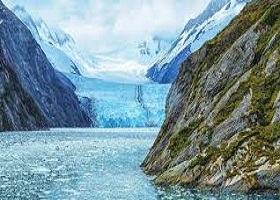
Day Scenic cruising Amalia or Brujo Glacier / Canal SarmientoCruising Only
Ice and weather. Thatââ¬â¢s what it all comes down to as ships make their way through this part of the world. On Chileââ¬â¢s coast along the Southern Patagonian Ice Field, ice buildup and quixotic weather conditions heavily dictate which routes ships can take. Even when passage is safe around the popular Amalia, El Brujo or numerous other breathtaking glaciers found here, misty rain or soupy fog might be the order of the day. And it can always shift in a flash, as glassy waters erupt into choppy wavesââ¬âor, more happily, shrouded peaks become flooded with sunlight sparkling off the ice fields, letting you relish a momentary peaceful stillness in the air.
Canal Sarmiento
One of the main channels in Patagonia, the Sarmiento Channel runs in a north-south direction, starting at the GuÃÂa Narrows and finishing at the southern edge of Victoria Pass, where it joins the Smyth Channel. The Kawesqar people have inhabited this region for more than 6,000 years, but the channel was named for a more recent arrival: the Spanish explorer Pedro Sarmiento de Gamboa, who first navigated it between 1579 and 1580. The Chilean mainland lies to the east, and the islands of Esperanza, Vancouver and Piazzi flank the channel to the west. As elsewhere in the Chilean fjord region, the ragged coastline is cut with inlets set among snow-covered mountain ranges. In many places, massive glaciers run down to the sea. All kinds of marine animals, including Magellanic penguins, southern elephant seals, dolphins and orcas, can be seen along these shores.
Ice and weather. Thatââ¬â¢s what it all comes down to as ships make their way through this part of the world. On Chileââ¬â¢s coast along the Southern Patagonian Ice Field, ice buildup and quixotic weather conditions heavily dictate which routes ships can take. Even when passage is safe around the popular Amalia, El Brujo or numerous other breathtaking glaciers found here, misty rain or soupy fog might be the order of the day. And it can always shift in a flash, as glassy waters erupt into choppy wavesââ¬âor, more happily, shrouded peaks become flooded with sunlight sparkling off the ice fields, letting you relish a momentary peaceful stillness in the air.
Canal Sarmiento
One of the main channels in Patagonia, the Sarmiento Channel runs in a north-south direction, starting at the GuÃÂa Narrows and finishing at the southern edge of Victoria Pass, where it joins the Smyth Channel. The Kawesqar people have inhabited this region for more than 6,000 years, but the channel was named for a more recent arrival: the Spanish explorer Pedro Sarmiento de Gamboa, who first navigated it between 1579 and 1580. The Chilean mainland lies to the east, and the islands of Esperanza, Vancouver and Piazzi flank the channel to the west. As elsewhere in the Chilean fjord region, the ragged coastline is cut with inlets set among snow-covered mountain ranges. In many places, massive glaciers run down to the sea. All kinds of marine animals, including Magellanic penguins, southern elephant seals, dolphins and orcas, can be seen along these shores.
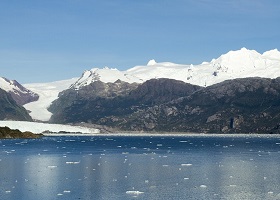
Day Strait of Magellan / Punta Arenas, Chile / Cockburn Channel / Beagle ChannelCruising Only / Arrives 06:00 AM Departs 06:00 PM / Cruising
The Strait of Magellan is one of the world's most important natural waterways, linking the Pacific and Atlantic Oceans. The strait passes below Chile and above Tierra del Fuego and Antarctica. The strait was named after the man that first navigated the waterway, Ferdinand Magellan, on his famous voyage as the first person to circumnavigate the entire globe.
Punta Arenas, Chile
If Punta Arenas exudes an "edge of the world" air, it's not without reason. This windblown city near Chile's southernmost tip sits on the Strait of Magellan, which itself is positioned squarely between the Atlantic and Pacific oceans. The city has playedâand continues to playâan important role in geographic, political and economic affairs in South America's so-called Southern Cone, which is formed by Chile and neighboring Argentina. Too many travelers rush through Punta Arenas, treating it as a pit stop on their way to the stunningly beautiful landscapes of Torres del Paine National Park and other attractions in Patagonia, but there's plenty in this city and its environs to experience, too. From penguin spotting on Isla Magdalena and kayaking the Strait of Magellan to visiting area farms and then indulging in surf-and-turf specialties (here meaning fresh seafood and asado, or Chilean barbecue) at local restaurants, Punta Arenas is worth a stopover all its own.
Cockburn Channel
"As you near the southern tip of South America, traveling along the Chilean or Pacific coast, you'll know that you're approaching the Cockburn (pronounced ""CO-burn"") Channel when you see the twin rocks that guard its entrance. The channel flows between the Brecknock Peninsula (the westernmost edge of Isla Grande de Tierra del Fuego) and a number of islands, including Clarence Island with its irregular coastline of dramatic sounds that reach deep into its interior. The channel is part of the route that connects the Strait of Magellan to the Beagle Channel, while along both sides of the waterway is one of the crown jewels of Chile's network of parks: Alberto de Agostini National Park."
Beagle Channel
Running through the Tierra del Fuego archipelago, the Beagle Channel is a scenic and wonderfully calm strait that has become a hugely popular cruise destination. Named in 1830 after a charting voyage by the HMS Beagleâthe ship that later became famous for carrying English naturalist Charles Darwin on his five-year journey of discoveryâthe channel is one of a trio of navigable passages around the tip of South America. Some 240 kilometers long (almost 150 miles), the channel extends from Nueva Island in the east to Darwin Sound and Cook Bay in the west. Its western end lies within Chile, and its eastern end forms a segment of the border between Chile and Argentina. By far the largest sight along the channel is the town of Ushuaia in Argentina, which has much to offer the day-tripper or overnight visitor. Other highlights of a cruise include a slew of natural sights, from views of snow-covered glaciers to wildlife spotting at Isla de los Lobos (also called Sea Lion Island) and Isla de los Pájaros (Bird Island).
The Strait of Magellan is one of the world's most important natural waterways, linking the Pacific and Atlantic Oceans. The strait passes below Chile and above Tierra del Fuego and Antarctica. The strait was named after the man that first navigated the waterway, Ferdinand Magellan, on his famous voyage as the first person to circumnavigate the entire globe.
Punta Arenas, Chile
If Punta Arenas exudes an "edge of the world" air, it's not without reason. This windblown city near Chile's southernmost tip sits on the Strait of Magellan, which itself is positioned squarely between the Atlantic and Pacific oceans. The city has playedâand continues to playâan important role in geographic, political and economic affairs in South America's so-called Southern Cone, which is formed by Chile and neighboring Argentina. Too many travelers rush through Punta Arenas, treating it as a pit stop on their way to the stunningly beautiful landscapes of Torres del Paine National Park and other attractions in Patagonia, but there's plenty in this city and its environs to experience, too. From penguin spotting on Isla Magdalena and kayaking the Strait of Magellan to visiting area farms and then indulging in surf-and-turf specialties (here meaning fresh seafood and asado, or Chilean barbecue) at local restaurants, Punta Arenas is worth a stopover all its own.
Cockburn Channel
"As you near the southern tip of South America, traveling along the Chilean or Pacific coast, you'll know that you're approaching the Cockburn (pronounced ""CO-burn"") Channel when you see the twin rocks that guard its entrance. The channel flows between the Brecknock Peninsula (the westernmost edge of Isla Grande de Tierra del Fuego) and a number of islands, including Clarence Island with its irregular coastline of dramatic sounds that reach deep into its interior. The channel is part of the route that connects the Strait of Magellan to the Beagle Channel, while along both sides of the waterway is one of the crown jewels of Chile's network of parks: Alberto de Agostini National Park."
Beagle Channel
Running through the Tierra del Fuego archipelago, the Beagle Channel is a scenic and wonderfully calm strait that has become a hugely popular cruise destination. Named in 1830 after a charting voyage by the HMS Beagleâthe ship that later became famous for carrying English naturalist Charles Darwin on his five-year journey of discoveryâthe channel is one of a trio of navigable passages around the tip of South America. Some 240 kilometers long (almost 150 miles), the channel extends from Nueva Island in the east to Darwin Sound and Cook Bay in the west. Its western end lies within Chile, and its eastern end forms a segment of the border between Chile and Argentina. By far the largest sight along the channel is the town of Ushuaia in Argentina, which has much to offer the day-tripper or overnight visitor. Other highlights of a cruise include a slew of natural sights, from views of snow-covered glaciers to wildlife spotting at Isla de los Lobos (also called Sea Lion Island) and Isla de los Pájaros (Bird Island).
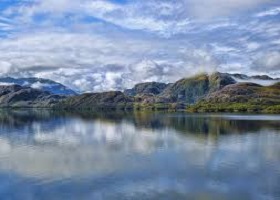
Day Daylight cruising Glacier Alley / Ushuaia, ArgentinaCruising / Arrives 12:00 PM Departs 08:00 PM
"As alleys go, this one is mighty long. Glacier Alleyâor, as it's more elegantly known, Avenue of the Glaciersâstretches along a good portion of the celebrated 240-kilometer-long (150-mile-long) Beagle Channel in the vast territory of Tierra del Fuego. Argentina's Ushuaia and Chile's Puerto Williams, both common starting points for travelers exploring Glacier Alley, are two of the world's southernmost towns. As you travel into the Beagle Channel, the vital waterway that allowed ships to avoid the hellish fury of the waters around Cape Horn, you follow the route that the famous HMS Beagle took with a young and then-unknown geologist and naturalist on board, Charles Darwin. While fighting the harsh elements, and with no creature comforts like the ones enjoyed today, those early sailors were at least treated to one stunning glacier after another, each flowing down from massive mountain ranges and peaks such as the snowcapped one named for Darwin himself. Even if your journey is shrouded in foggy mist, you can't miss the cracking sound of the blue ice as it tumbles into the channel or the rush of ice-melt waterfalls. Along with all these natural wonders, a visit to Glacier Alley comes with opportunities to see penguin rookeries, humpback whales and seals."
Ushuaia, Argentina
"Dramatic, fantastical, otherworldlyâthis is the end of the world, for real. Positioned at the southernmost tip of Argentina, this memorable port town is cradled between the pristineâand toweringâMartial Mountains and accessed by the picturesque Beagle Channel (which was named for Darwin's famed vessel). Ushuaia is the capital of the Tierra del Fuego region, which is best described as a spectacular collection of superlative natural wonders. It's a veritable kaleidoscope of glittering glaciers, snowcapped mountains, dense forests, sparkling lakes and windswept plains spread across an archipelago of rugged islands. The town itself is a maze of streets lined with low-slung buildings that all seem to meet at its heart, the port. Founded in 1884, the far-flung spot welcomed missionaries, gold prospectors and naval officers before becoming known primarily as a penal colony. After its closure under the infamous Argentine leader Juan Perón, the large jail was reconfigured to house one of the city's most popular museums. Other current in-town attractions include a maritime museum and a museum dedicated to the region's natural history, as well as restaurants preparing the marquee offeringâlocal king crab.
"As alleys go, this one is mighty long. Glacier Alleyâor, as it's more elegantly known, Avenue of the Glaciersâstretches along a good portion of the celebrated 240-kilometer-long (150-mile-long) Beagle Channel in the vast territory of Tierra del Fuego. Argentina's Ushuaia and Chile's Puerto Williams, both common starting points for travelers exploring Glacier Alley, are two of the world's southernmost towns. As you travel into the Beagle Channel, the vital waterway that allowed ships to avoid the hellish fury of the waters around Cape Horn, you follow the route that the famous HMS Beagle took with a young and then-unknown geologist and naturalist on board, Charles Darwin. While fighting the harsh elements, and with no creature comforts like the ones enjoyed today, those early sailors were at least treated to one stunning glacier after another, each flowing down from massive mountain ranges and peaks such as the snowcapped one named for Darwin himself. Even if your journey is shrouded in foggy mist, you can't miss the cracking sound of the blue ice as it tumbles into the channel or the rush of ice-melt waterfalls. Along with all these natural wonders, a visit to Glacier Alley comes with opportunities to see penguin rookeries, humpback whales and seals."
Ushuaia, Argentina
"Dramatic, fantastical, otherworldlyâthis is the end of the world, for real. Positioned at the southernmost tip of Argentina, this memorable port town is cradled between the pristineâand toweringâMartial Mountains and accessed by the picturesque Beagle Channel (which was named for Darwin's famed vessel). Ushuaia is the capital of the Tierra del Fuego region, which is best described as a spectacular collection of superlative natural wonders. It's a veritable kaleidoscope of glittering glaciers, snowcapped mountains, dense forests, sparkling lakes and windswept plains spread across an archipelago of rugged islands. The town itself is a maze of streets lined with low-slung buildings that all seem to meet at its heart, the port. Founded in 1884, the far-flung spot welcomed missionaries, gold prospectors and naval officers before becoming known primarily as a penal colony. After its closure under the infamous Argentine leader Juan Perón, the large jail was reconfigured to house one of the city's most popular museums. Other current in-town attractions include a maritime museum and a museum dedicated to the region's natural history, as well as restaurants preparing the marquee offeringâlocal king crab.
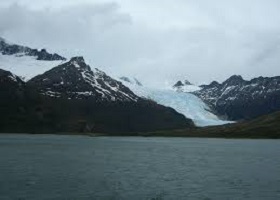
Day Cape Horn and Drake PassageCruising Only
Thanks to its locationâon one of the southernmost points in South AmericaâCape Horn has played a major role in navigational history. The Strait of Magellan to the north was discovered first, but that route's narrow width was challenging to navigate. Cape Horn, discovered by the Dutch in 1615, became the primary route for trade ships traveling from Europe or the east side of the Americas to the American West Coast. Cape Horn marks the entrance to the Drake Passage, where the Atlantic and Pacific oceans meet. Until the Panama Canal opened in 1914, this was one of the planet's major shipping routes. Strong winds, currents, waves and icebergs made the passage fairly treacherous in the days of sailing ships. Even today, ârounding the Hornâ remains a challenge for the many yacht races that pass through its icy waters. Hornos, the island where Cape Horn is located, may look desolate and treeless, but it's home to a vast number of gulls and other seabirds.
Thanks to its locationâon one of the southernmost points in South AmericaâCape Horn has played a major role in navigational history. The Strait of Magellan to the north was discovered first, but that route's narrow width was challenging to navigate. Cape Horn, discovered by the Dutch in 1615, became the primary route for trade ships traveling from Europe or the east side of the Americas to the American West Coast. Cape Horn marks the entrance to the Drake Passage, where the Atlantic and Pacific oceans meet. Until the Panama Canal opened in 1914, this was one of the planet's major shipping routes. Strong winds, currents, waves and icebergs made the passage fairly treacherous in the days of sailing ships. Even today, ârounding the Hornâ remains a challenge for the many yacht races that pass through its icy waters. Hornos, the island where Cape Horn is located, may look desolate and treeless, but it's home to a vast number of gulls and other seabirds.
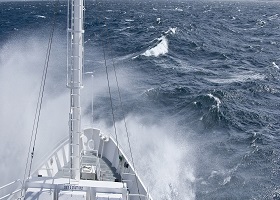
Day At Sea
Day Antarctic ExperienceArrives 08:00 AM Departs 06:00 PM
After a day and a half crossing the Drake Passage, which separates South America from Antarctica, your ship will arrive at the White Continent. On your Antarctic Expedition you will sail through the bays and islands of the Palmer Archipelago, off the northern tip of the long Antarctic Peninsula, which reaches out toward South America.Encircled in a landscape of snow and ice in every direction, your ship will slowly navigate the iceberg-dotted waters. The surroundings are hauntingly quiet as well, an aspect of the continent that comes as a surprise to many first-time visitors. Along the way, the ship's naturalists will point out the birdsââ¬âterns, petrels, and gullsââ¬âfound on the coast and on small islets at stops like Dallmann Bay. As you pass dark, rocky Cuverville Island, youââ¬â¢ll see some of the 6,500 pairs of gentoo penguins that make their home there, the largest known colony in the world. Continuing on to Paradise Harbor, you'll have a chance to observe not only gentoo and chinstrap penguins but possibly humans as well: Both Argentina and Chile have manned research stations here.
After a day and a half crossing the Drake Passage, which separates South America from Antarctica, your ship will arrive at the White Continent. On your Antarctic Expedition you will sail through the bays and islands of the Palmer Archipelago, off the northern tip of the long Antarctic Peninsula, which reaches out toward South America.Encircled in a landscape of snow and ice in every direction, your ship will slowly navigate the iceberg-dotted waters. The surroundings are hauntingly quiet as well, an aspect of the continent that comes as a surprise to many first-time visitors. Along the way, the ship's naturalists will point out the birdsââ¬âterns, petrels, and gullsââ¬âfound on the coast and on small islets at stops like Dallmann Bay. As you pass dark, rocky Cuverville Island, youââ¬â¢ll see some of the 6,500 pairs of gentoo penguins that make their home there, the largest known colony in the world. Continuing on to Paradise Harbor, you'll have a chance to observe not only gentoo and chinstrap penguins but possibly humans as well: Both Argentina and Chile have manned research stations here.
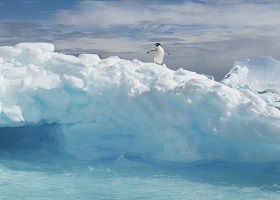
Day Antarctic ExperienceArrives 08:00 AM Departs 06:00 PM
After a day and a half crossing the Drake Passage, which separates South America from Antarctica, your ship will arrive at the White Continent. On your Antarctic Expedition you will sail through the bays and islands of the Palmer Archipelago, off the northern tip of the long Antarctic Peninsula, which reaches out toward South America.Encircled in a landscape of snow and ice in every direction, your ship will slowly navigate the iceberg-dotted waters. The surroundings are hauntingly quiet as well, an aspect of the continent that comes as a surprise to many first-time visitors. Along the way, the ship's naturalists will point out the birdsââ¬âterns, petrels, and gullsââ¬âfound on the coast and on small islets at stops like Dallmann Bay. As you pass dark, rocky Cuverville Island, youââ¬â¢ll see some of the 6,500 pairs of gentoo penguins that make their home there, the largest known colony in the world. Continuing on to Paradise Harbor, you'll have a chance to observe not only gentoo and chinstrap penguins but possibly humans as well: Both Argentina and Chile have manned research stations here.
After a day and a half crossing the Drake Passage, which separates South America from Antarctica, your ship will arrive at the White Continent. On your Antarctic Expedition you will sail through the bays and islands of the Palmer Archipelago, off the northern tip of the long Antarctic Peninsula, which reaches out toward South America.Encircled in a landscape of snow and ice in every direction, your ship will slowly navigate the iceberg-dotted waters. The surroundings are hauntingly quiet as well, an aspect of the continent that comes as a surprise to many first-time visitors. Along the way, the ship's naturalists will point out the birdsââ¬âterns, petrels, and gullsââ¬âfound on the coast and on small islets at stops like Dallmann Bay. As you pass dark, rocky Cuverville Island, youââ¬â¢ll see some of the 6,500 pairs of gentoo penguins that make their home there, the largest known colony in the world. Continuing on to Paradise Harbor, you'll have a chance to observe not only gentoo and chinstrap penguins but possibly humans as well: Both Argentina and Chile have manned research stations here.

Day Antarctic ExperienceArrives 08:00 AM Departs 06:00 PM
After a day and a half crossing the Drake Passage, which separates South America from Antarctica, your ship will arrive at the White Continent. On your Antarctic Expedition you will sail through the bays and islands of the Palmer Archipelago, off the northern tip of the long Antarctic Peninsula, which reaches out toward South America.Encircled in a landscape of snow and ice in every direction, your ship will slowly navigate the iceberg-dotted waters. The surroundings are hauntingly quiet as well, an aspect of the continent that comes as a surprise to many first-time visitors. Along the way, the ship's naturalists will point out the birdsââ¬âterns, petrels, and gullsââ¬âfound on the coast and on small islets at stops like Dallmann Bay. As you pass dark, rocky Cuverville Island, youââ¬â¢ll see some of the 6,500 pairs of gentoo penguins that make their home there, the largest known colony in the world. Continuing on to Paradise Harbor, you'll have a chance to observe not only gentoo and chinstrap penguins but possibly humans as well: Both Argentina and Chile have manned research stations here.
After a day and a half crossing the Drake Passage, which separates South America from Antarctica, your ship will arrive at the White Continent. On your Antarctic Expedition you will sail through the bays and islands of the Palmer Archipelago, off the northern tip of the long Antarctic Peninsula, which reaches out toward South America.Encircled in a landscape of snow and ice in every direction, your ship will slowly navigate the iceberg-dotted waters. The surroundings are hauntingly quiet as well, an aspect of the continent that comes as a surprise to many first-time visitors. Along the way, the ship's naturalists will point out the birdsââ¬âterns, petrels, and gullsââ¬âfound on the coast and on small islets at stops like Dallmann Bay. As you pass dark, rocky Cuverville Island, youââ¬â¢ll see some of the 6,500 pairs of gentoo penguins that make their home there, the largest known colony in the world. Continuing on to Paradise Harbor, you'll have a chance to observe not only gentoo and chinstrap penguins but possibly humans as well: Both Argentina and Chile have manned research stations here.

Day Antarctic ExperienceArrives 08:00 AM Departs 06:00 PM
After a day and a half crossing the Drake Passage, which separates South America from Antarctica, your ship will arrive at the White Continent. On your Antarctic Expedition you will sail through the bays and islands of the Palmer Archipelago, off the northern tip of the long Antarctic Peninsula, which reaches out toward South America.Encircled in a landscape of snow and ice in every direction, your ship will slowly navigate the iceberg-dotted waters. The surroundings are hauntingly quiet as well, an aspect of the continent that comes as a surprise to many first-time visitors. Along the way, the ship's naturalists will point out the birdsââ¬âterns, petrels, and gullsââ¬âfound on the coast and on small islets at stops like Dallmann Bay. As you pass dark, rocky Cuverville Island, youââ¬â¢ll see some of the 6,500 pairs of gentoo penguins that make their home there, the largest known colony in the world. Continuing on to Paradise Harbor, you'll have a chance to observe not only gentoo and chinstrap penguins but possibly humans as well: Both Argentina and Chile have manned research stations here.
After a day and a half crossing the Drake Passage, which separates South America from Antarctica, your ship will arrive at the White Continent. On your Antarctic Expedition you will sail through the bays and islands of the Palmer Archipelago, off the northern tip of the long Antarctic Peninsula, which reaches out toward South America.Encircled in a landscape of snow and ice in every direction, your ship will slowly navigate the iceberg-dotted waters. The surroundings are hauntingly quiet as well, an aspect of the continent that comes as a surprise to many first-time visitors. Along the way, the ship's naturalists will point out the birdsââ¬âterns, petrels, and gullsââ¬âfound on the coast and on small islets at stops like Dallmann Bay. As you pass dark, rocky Cuverville Island, youââ¬â¢ll see some of the 6,500 pairs of gentoo penguins that make their home there, the largest known colony in the world. Continuing on to Paradise Harbor, you'll have a chance to observe not only gentoo and chinstrap penguins but possibly humans as well: Both Argentina and Chile have manned research stations here.

Day At Sea
Day Stanley/Falkland Is/Islas MalvinasArrives 08:00 AM Departs 04:00 PM
The world's southernmost capital, Stanley is located in the Falklands archipelago, which consists of two main islands, East and West Falkland, along with smaller islands nearby. Stanley is proud of its British heritage, evidenced everywhere from its red telephone boxes to its pubs. The Falklands were first claimed by the English in 1765; over the centuries the Crown has had to abandon, reclaim and defend these far-flung islands from invading nationsâincluding an Argentine foray in 1982. During the early years of their colonization, the Falklands were used as a base for ships hunting sperm whales for oil, followed by those hunting seals for fur. Today in this remote British territory, fishing and tourism are what drive the economy.
The world's southernmost capital, Stanley is located in the Falklands archipelago, which consists of two main islands, East and West Falkland, along with smaller islands nearby. Stanley is proud of its British heritage, evidenced everywhere from its red telephone boxes to its pubs. The Falklands were first claimed by the English in 1765; over the centuries the Crown has had to abandon, reclaim and defend these far-flung islands from invading nationsâincluding an Argentine foray in 1982. During the early years of their colonization, the Falklands were used as a base for ships hunting sperm whales for oil, followed by those hunting seals for fur. Today in this remote British territory, fishing and tourism are what drive the economy.
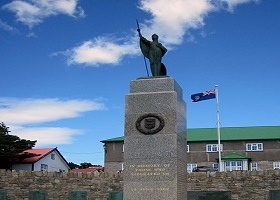
Day At Sea
Day Solar Eclipse ExperienceArrives 11:00 AM Departs 04:00 PM
What better way to experience ââ¬Åtotalityââ¬Â than on the wraparound deck of a perfectly sized ship, far from the light and distractions of shore? Join us for this rare and memorable cosmic phenomenon.
What better way to experience ââ¬Åtotalityââ¬Â than on the wraparound deck of a perfectly sized ship, far from the light and distractions of shore? Join us for this rare and memorable cosmic phenomenon.
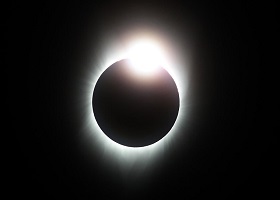
Day Puerto Madryn, ArgentinaArrives 07:00 AM Departs 03:00 PM
"To a Spanish speaker, the name of Puerto Madryn, a city of some 94,000 in northern Patagonia in Argentina, may look odd. That second word doesn't appear to be Spanish, because it's not. Love Jones-Parry, a prominent Welsh landowner, traveled to Patagonia in 1862 to determine whether the area was appropriate for Welsh settlers. When his ship was blown off course, he named the bay where it landed Porth Madryn, after his estate in Wales. In 1865, a group of 162 Welsh immigrants (other sources put the figure at 150), encouraged by Jones-Parry's favorable reports, sailed to Argentina to establish the settlement known today as Puerto Madryn. Traces of the city's British roots remainâyou can find restaurants that still serve afternoon tea. But for most travelers today, Puerto Madryn is best known as the gateway to the PenÃnsula Valdés, a UNESCO World Heritage Site that's home to significant populations of seals, sea lions and whales just offshore. While the natural wonders and the region's fauna are the main draws, it's worth spending some time exploring the restaurant-lined promenades and beaches that have made the city an increasingly popular resort destination. "
"To a Spanish speaker, the name of Puerto Madryn, a city of some 94,000 in northern Patagonia in Argentina, may look odd. That second word doesn't appear to be Spanish, because it's not. Love Jones-Parry, a prominent Welsh landowner, traveled to Patagonia in 1862 to determine whether the area was appropriate for Welsh settlers. When his ship was blown off course, he named the bay where it landed Porth Madryn, after his estate in Wales. In 1865, a group of 162 Welsh immigrants (other sources put the figure at 150), encouraged by Jones-Parry's favorable reports, sailed to Argentina to establish the settlement known today as Puerto Madryn. Traces of the city's British roots remainâyou can find restaurants that still serve afternoon tea. But for most travelers today, Puerto Madryn is best known as the gateway to the PenÃnsula Valdés, a UNESCO World Heritage Site that's home to significant populations of seals, sea lions and whales just offshore. While the natural wonders and the region's fauna are the main draws, it's worth spending some time exploring the restaurant-lined promenades and beaches that have made the city an increasingly popular resort destination. "
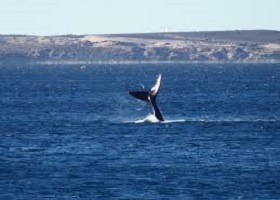
Day At Sea
Day Montevideo, UruguayArrives 09:00 AM Departs 06:00 PM
"Uruguay's capital, Montevideo, often gets overshadowed by her larger, flashier sister across the RÃo de la Plata, Buenos Aires. While Montevideo may not have quite the bustle of Argentina's capital, it shares that city's cosmopolitan atmosphere and, of course, excellent steak houses. Its smaller size is also an advantage: There is a relaxed feel to this more low-key counterpart to BA. Montevideo has a surprising mix of neighborhoods. The Ciudad Vieja, with its grid of streets on a peninsula separating the RÃo de la Plata from the harbor, is the colonial heart. Long neglected, it has recently undergone a renaissanceârestaurants, bars and clubs are opening in historic buildings that have been meticulously restored. Montevideo's downtown is a treasure trove of Art Deco buildings, while the newer eastern suburbs may evoke Miami for visitors. Gleaming skyscrapers and open-air cafés overlook beaches that run for miles."
"Uruguay's capital, Montevideo, often gets overshadowed by her larger, flashier sister across the RÃo de la Plata, Buenos Aires. While Montevideo may not have quite the bustle of Argentina's capital, it shares that city's cosmopolitan atmosphere and, of course, excellent steak houses. Its smaller size is also an advantage: There is a relaxed feel to this more low-key counterpart to BA. Montevideo has a surprising mix of neighborhoods. The Ciudad Vieja, with its grid of streets on a peninsula separating the RÃo de la Plata from the harbor, is the colonial heart. Long neglected, it has recently undergone a renaissanceârestaurants, bars and clubs are opening in historic buildings that have been meticulously restored. Montevideo's downtown is a treasure trove of Art Deco buildings, while the newer eastern suburbs may evoke Miami for visitors. Gleaming skyscrapers and open-air cafés overlook beaches that run for miles."
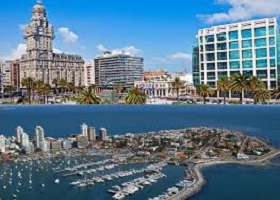
Day Buenos Aires, Argentina--
"In the early 20th century, Buenos Aires, Argentina, gained immense wealth when it began shipping its pampas-raised beef around the world. It quickly entered the club of great world cities, and a slew of attractions and architectural jewels soon arose. Since that time, the capital has experienced huge swings in economic and political fortune. But Buenos Aires continues to fascinate and entertain sightseeing visitors, both for its chaotic energy and for its sheer urban beauty. Thankfully, the Belle Ãpoque grandeur and enormous tracts of greenery remain. Any list of things to do in Buenos Aires would begin with its many walkable neighborhoods; Palermo especially stands out, thanks to creative residents who have pushed the restaurant scene well beyond beef. Porteñosâas the locals are calledâmay be of Spanish, Italian, Jewish or Middle Eastern descent; that mix of cultures is reflected in the city's dialect, foods and pastimes. Looking beyond the city's sights, Buenos Aires is known as the birthplace of tango, and while the music and dance never quite went away, today tango is making a resurgence. Fans come here from around the world to take part in or watch the milongas (dance events). Argentines are world leaders in polo as well, and as the sport captures the interest of more and more travelers, hunky players like Nacho are gaining global celebrity. "
"In the early 20th century, Buenos Aires, Argentina, gained immense wealth when it began shipping its pampas-raised beef around the world. It quickly entered the club of great world cities, and a slew of attractions and architectural jewels soon arose. Since that time, the capital has experienced huge swings in economic and political fortune. But Buenos Aires continues to fascinate and entertain sightseeing visitors, both for its chaotic energy and for its sheer urban beauty. Thankfully, the Belle Ãpoque grandeur and enormous tracts of greenery remain. Any list of things to do in Buenos Aires would begin with its many walkable neighborhoods; Palermo especially stands out, thanks to creative residents who have pushed the restaurant scene well beyond beef. Porteñosâas the locals are calledâmay be of Spanish, Italian, Jewish or Middle Eastern descent; that mix of cultures is reflected in the city's dialect, foods and pastimes. Looking beyond the city's sights, Buenos Aires is known as the birthplace of tango, and while the music and dance never quite went away, today tango is making a resurgence. Fans come here from around the world to take part in or watch the milongas (dance events). Argentines are world leaders in polo as well, and as the sport captures the interest of more and more travelers, hunky players like Nacho are gaining global celebrity. "

Day Buenos Aires, ArgentinaArrives 08:00 AM
"In the early 20th century, Buenos Aires, Argentina, gained immense wealth when it began shipping its pampas-raised beef around the world. It quickly entered the club of great world cities, and a slew of attractions and architectural jewels soon arose. Since that time, the capital has experienced huge swings in economic and political fortune. But Buenos Aires continues to fascinate and entertain sightseeing visitors, both for its chaotic energy and for its sheer urban beauty. Thankfully, the Belle Ãpoque grandeur and enormous tracts of greenery remain. Any list of things to do in Buenos Aires would begin with its many walkable neighborhoods; Palermo especially stands out, thanks to creative residents who have pushed the restaurant scene well beyond beef. Porteñosâas the locals are calledâmay be of Spanish, Italian, Jewish or Middle Eastern descent; that mix of cultures is reflected in the city's dialect, foods and pastimes. Looking beyond the city's sights, Buenos Aires is known as the birthplace of tango, and while the music and dance never quite went away, today tango is making a resurgence. Fans come here from around the world to take part in or watch the milongas (dance events). Argentines are world leaders in polo as well, and as the sport captures the interest of more and more travelers, hunky players like Nacho are gaining global celebrity. "
"In the early 20th century, Buenos Aires, Argentina, gained immense wealth when it began shipping its pampas-raised beef around the world. It quickly entered the club of great world cities, and a slew of attractions and architectural jewels soon arose. Since that time, the capital has experienced huge swings in economic and political fortune. But Buenos Aires continues to fascinate and entertain sightseeing visitors, both for its chaotic energy and for its sheer urban beauty. Thankfully, the Belle Ãpoque grandeur and enormous tracts of greenery remain. Any list of things to do in Buenos Aires would begin with its many walkable neighborhoods; Palermo especially stands out, thanks to creative residents who have pushed the restaurant scene well beyond beef. Porteñosâas the locals are calledâmay be of Spanish, Italian, Jewish or Middle Eastern descent; that mix of cultures is reflected in the city's dialect, foods and pastimes. Looking beyond the city's sights, Buenos Aires is known as the birthplace of tango, and while the music and dance never quite went away, today tango is making a resurgence. Fans come here from around the world to take part in or watch the milongas (dance events). Argentines are world leaders in polo as well, and as the sport captures the interest of more and more travelers, hunky players like Nacho are gaining global celebrity. "
